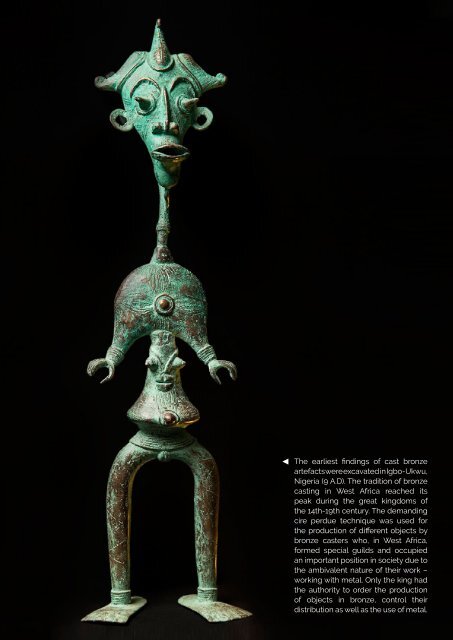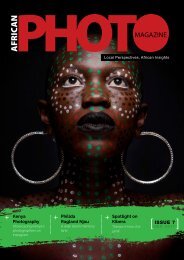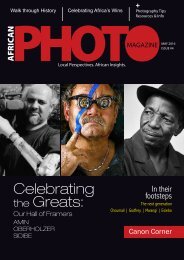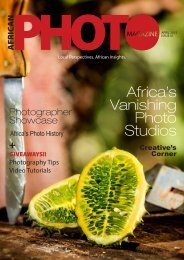African Photo Magazine Issue #6
This is the 6th issue of the Pan-African photography magazine, African Photo Magazine and the main showcase is Ghana Photography. Additionally, we showcase African photographers and visual artists showcased by Performa, Red Hook Labs and Nataal in 2017, in New York City.
This is the 6th issue of the Pan-African photography magazine, African Photo Magazine and the main showcase is Ghana Photography. Additionally, we showcase African photographers and visual artists showcased by Performa, Red Hook Labs and Nataal in 2017, in New York City.
Create successful ePaper yourself
Turn your PDF publications into a flip-book with our unique Google optimized e-Paper software.
Historians estimate that between 10<br />
and 18 million <strong>African</strong>s were enslaved<br />
by Arab slave traders and taken<br />
across the Red Sea, Indian Ocean,<br />
and Sahara desert between 650 A.D<br />
and 1900 A.D, long before the Atlantic<br />
Slave trade. At the height of the Indian<br />
Ocean slave trade, it was estimated<br />
that 80,000 <strong>African</strong>s died each<br />
year before ever reaching the slave<br />
markets of Zanzibar. Zanzibar was<br />
once East Africa’s main slave-trading<br />
port, and under Omani Arabs in the<br />
19th century as many as 50,000<br />
slaves were passing through the city<br />
each year.<br />
The earliest findings of cast bronze<br />
artefacts were excavated in Igbo-Ukwu,<br />
Nigeria (9 A.D). The tradition of bronze<br />
casting in West Africa reached its<br />
peak during the great kingdoms of<br />
the 14th-19th century. The demanding<br />
cire perdue technique was used for<br />
the production of different objects by<br />
bronze casters who, in West Africa,<br />
formed special guilds and occupied<br />
an important position in society due to<br />
the ambivalent nature of their work –<br />
working with metal. Only the king had<br />
the authority to order the production<br />
of objects in bronze, control their<br />
distribution as well as the use of metal.<br />
Nkisi or Nkishi are spirits, or an<br />
object that a spirit inhabits. It is<br />
frequently applied to a variety of<br />
objects used throughout the Congo<br />
Basin in Central Africa that are<br />
believed to contain spiritual powers<br />
or spirits. Close communication with<br />
ancestors and belief in the efficacy of<br />
their powers are closely associated in<br />
Kongo tradition. Among the peoples<br />
of the Congo Basin, especially the<br />
Bakongo and the Songye people of<br />
Kasai, exceptional human powers<br />
are frequently believed to result<br />
from some sort of communication<br />
with the dead. People known as<br />
banganga work as healers, diviners,<br />
and mediators who defend the living<br />
against witchcraft and provide them<br />
with remedies against diseases<br />
resulting either from witchcraft or the<br />
demands of bakisi (spirits), emissaries<br />
from the land of the dead.<br />
The Senufo of northern Côte d’Ivoire<br />
produce a rich variety of sculptures,<br />
mainly associated with Poro, a society<br />
guided by a female ancestral spirit<br />
known as “the Ancient Mother.” Several<br />
types of mask are used in conjunction<br />
with Poro. Kponyugu masks exhibit<br />
many variations in name, style, animal<br />
references, and symbolism. Their<br />
iconography—a composite of a wide<br />
range of animals—refers to the origin<br />
of the world, to important legends,<br />
and to the roles of certain animals in<br />
carrying out obligations to ancestors<br />
and nature spirits. The kpelie masks,<br />
small human faces with delicate<br />
features, represent female spirits and<br />
encode aspects of Poro knowledge.<br />
The masks are involved with initiation<br />
and also perform at funerals, where<br />
they help encourage the soul of the<br />
deceased to move on to the ancestral<br />
realm.<br />
Makonde sculpture, old and<br />
modern, represents an artistic<br />
tradition which evolved in response<br />
to the historical and economic forces<br />
affecting the Makonde, of southern<br />
Tanzania, throughout the twentieth<br />
century, especially after the 1930s.<br />
The carvings are both traditional and<br />
contemporary, reflecting a tribal past<br />
as well as modern response to urban<br />
life. The most common is the “Tree<br />
of Life” which depicts the members<br />
of an extended family, including<br />
past and present generations, gently<br />
supporting each other, generation<br />
after generation, around the family<br />
ancestor<br />
10 africanphotomagazine ISSUE 6 JUNE 2017 11










